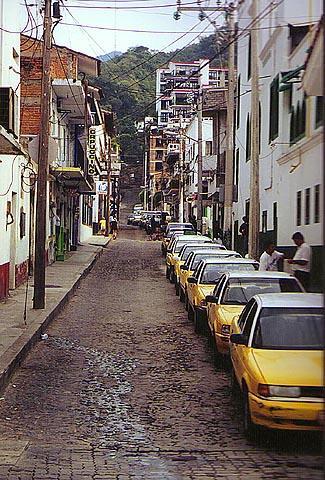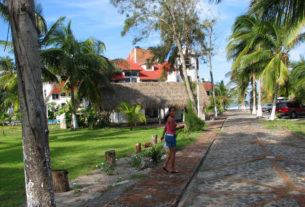*Statistics from Multi List Vallarta

The last decade of the millennium has brought a multitude of changes to the real estate market of Puerto Vallarta. The effects of this can be seen by the expansion of the market itself beyond the confines of the Bay of Banderas. New phrases have been coined to describe the growing residential areas. It is no longer referred to as just Puerto Vallarta, but rather Costa Vallarta, which now defines the region between Mismaloya and Punta de Mita.
Vacation condos have been joined by luxury dream homes. New laws and international agreements have made purchasing properties easier than ever before. Up markets and down markets have been weathered. Industry professionals established an association of conformity to keep up with the demands of an expanding marketplace.
In this article several local realtors give their views on the past decade of real estate activities in Puerto Vallarta and their predictions for the future.
Major Influences of change.
Ten years ago, it was very hard for realtors to explain the trust system that was then in place for acquisition of Mexican land rights for foreigners who would be purchasers This trust system, or Fideicomiso, was implemented in 1973 by the Mexican government and established a way in which foreigners could get the equivalent of an actual title. The law was codified in December, 1993, providing foreigners with the ability to acquire residential real estate through a bank trust. It requires any one of the privately held Mexican banks to act as trustee. The bank holds title to the property, in trust, to which the purchaser/s are the beneficiary. They have all the rights of ownership to the property and may sell, lease, mortgage, improve, and pass as inheritance, just as with a regular title.
New Foreign Investment Law and the North American Fair Trade Agreement, NAFTA
In 1992, NAFTA institutionalized the consistency of how business is done between Mexico, The United States and Canada, giving purchasers investment protection and reducing the distortions of the industry. According to Silvia Elias, of PV Realty and President of AMPI, Mexico’s association of professional realtors, the NAFTA agreement “was the major reason for the real estate boom in the coastal areas of Mexico. It gave security to buying real estate in Mexico. This, as well as the modernization of Mexican laws pertaining to the conversion of ejido-agrarian land to private status for investment, have increased real estate opportunities tremendously.”
The agrarian law of 1992 opened up ejido beach and farmlands for foreign development. This is significant because approximately 50% of the entire land area of Mexico are ejido-agrarian lands and sale/purchase of these properties are banned. Converting ejido land for private use at one time required a presidential decree; but it is now within the jurisdiction of local municipal governments.
With the advent of increased property available for foreign investments, including rights to and deeds for, came long term financing and title insurance. These American services enabled the real estate market to gain the faith of an ever-increasing North American market. Brock Squire of Brock Squire Y Asociados states, “There was no financing 10 years ago, it was all cash or the vendor would take back short term loans of two to three years. Inland Mortgage started making loans here after 3 years of research and due diligence, allowing US residents to borrow US funds with Mexican property as collateral. These special programs are designed for Mexican property purchase with FHA underwriting standards, with long term fixed interest rates of 9 ¾ to 10%, plus points.”
These factors along with a good U.S. and Canadian economy have kept the market strong and have added to its forward growth. While properties have retained the “Vallarta style and charm,” they have changed to meet demands. Items such as Sub Zero refrigerators, central air conditioning, and solid wood kitchens were unheard of and unavailable ten years ago. Another new advancement is the “turn-key” concept. Condos and villas are now designed to include everything needed to move in the day of closing. These homes are completely outfitted from sheets to staff.
Unheard of in 1989 was the million-dollar plus market. According to Multi-List Vallarta, the most expensive home on the market at that time was $900.000, which sold for considerably less. In 1999, the market is off to the races with seven properties currently listed in the one to two million-dollar price ranges. The two million-dollar plus marketplace exists - there are four now listed from $2,450.000 to $3,875.000 — but is the subject of controversy among industry professionals. Some say it is a case of over-reaching the market while others say that it shows a confidence in it.
The number of new construction starts in the “spec” home, custom, and pre-sale market, as well as the volume of re-sale properties in all price ranges, have steadily increased over the last five years, another sign of consumer and lender confidence.
The most sought-after property still contains the same ingredients: view, value, design, location, and price. The highest selling market remains the two-bedroom condominium and the three-bedroom single family residence, which has had the largest inventory. In 1990, there were 98 two bedroom condos withh an average list price of $116,564.79. In the second quarter of this year, the number is 74, with the average list price of $205,925. These numbers are somewhat inflated due to a small number of higher priced luxury units in the Conchas Chinas area.
The average 1999 Marina Vallarta property list price of $122,663 is a truer reflection of the 2bedroom condo market. The number of 3 bedrooms homes on the market in 1990 is the same as today, forty. Ten years ago these 3-bedroom houses had an average list price of $217,942. Today the same house would cost $241,215. The 1999 prices are within the $150,000.00 to $250,000.00 price range that the realtors agree is the main marketplace at this time.
However, houses with four and five bedrooms have doubled in asking price with very little inventory growth. That market had seventeen homes available in ’90 compared with twenty three today. Yet, in 1990, an average 4-bedroom home was asking $257,000, now it is $492,626. The five bedroom market has doubled in not only price but inventory as well. Ten years ago there were only eight such houses on the market at an average price of $553,750.00. Currently, there are nineteen listed with the average asking price of $908,139.
These statistics show steady upward market growth and return of investment for foreign investors of property in Puerto Vallarta.
Today vs. Yesterday
Real estate professionals agree that buyers today are more sophisticated. They have educated themselves with market trends and thus are more market savvy than ever before. Moray Applegate of Applegate Realtors defines them as a “highly successful, high end type of clientele who force us to be cutting edge.” He goes on to say, “more East Coast Americans, Canadians and Europeans are purchasing here, yet 60% to 70% of the buyers are from the Mid West and West Coast of the U.S. They range from 45 to 70 years old, retired or semi retired, who want to spend 2 to 3 months out of the year here.”
Giovanna Mosqueda of Century 21 Giovanna concurs, adding, “We are seeing younger buyers today, buying with cash — couples in their 30s and 40s who are buying condos. And, the alternative lifestyle market is also growing substantially.” Sra. Mosqueda also notes that there is “a growing national [Mexican] market of businessmen and their families who are purchasing here.”
Sr. Applegate explains that, along with homebuyers, “foreign developers are also investing, as they know what the buyers want and can produce it.” Sra. Mosqueda agrees, stating “the developers are answering the buyers demands.” Puerto Vallarta has been and remains an attractive market due its close proximity to the United States and Canada. Buyers are also now being attracted to the properties here because of the state of the art product these developers build. They know that their investment dollar will be spent on a home with all the conveniences they are used to and want.
Expanding Residential Region
Current prosperity in real estate has driven the market beyond the borders of Puerto Vallarta. Today realtors represent properties south from Boca de Tomatlan and north to San Pancho. Local satellite offices are popping up to serve these outlying areas. Mega-resorts with residential communities including golf courses, spas, upscale club houses, and ultra modern homes can be found in varying degrees of completion all along the coast of Nayarit. Development trends between Nuevo Vallarta and Punta de Mita, according to realtor Brock Squire ,”Are being driven by the new four lane highway and pulled by the 150 million dollar Punta de Mita 4 Season resort and 1500 acre planned development.”
Moray Applegate further explains this trend; “Real estate is going where the land and the nicer beaches are. Sayulita, Punta de Mita and San Pancho attract many with their sleepy village feeling. The new road is a major force that has exploded Nayarit. Soon, with the driving time reduced, Punta de Mita will only be a 15-minute longer drive (from Nuevo Vallarta) than it is to Conchas Chinas. There are gains in the north shore market as well. In 1989 a beachfront home with three lots in Nuevo Vallarta listed at $850,000. Currently there is a comparable property listed in the same area for 3 million dollars. Furthermore, in today’s market just a residential beachfront lot in the same area lists for $700.000 to $950.000.
However, Silvia Elias reports, “there are only spotty areas of double and triple gains, not all markets experience this.” Not to be overlooked is the even further expansion of development up the Nayarit coast to Plantanitos. Along this shoreline, two major ecologically conservative housing developments have taken the market to the pristine beaches of these outer reaches, proving that to “get away from it all” may take a little more travel in the next century.This northward expansion shows the continued popularity and security that foreign investors find in Costa Vallarta.
Estate Industry Changes
Estate markets are cyclical. It is a matter of supply and demand. The last upswing began ten years ago with the development of Marina Vallarta. This took the stress off the downtown area by providing a new type of residential product, the beachfront and/or golf course home. This saved the downtown core for hotel chains and condominium projects without sacrificing the colonial village image. Within six years the Marina was basically sold out, just as market demand was dwindling. By 1994, there were essentially no new developments or projects starting and the Mexican economy soon put a stop to whatever market there was. Transactions then consisted purely of re-sales, which ultimately took care of the excess supply. Prices reflected this down swing and began to moderate and in some markets show a loss. By 1997 there began to be more of a demand for product than what was available. Now at the dawn of a new millennium Puerto Vallarta is experiencing unprecedented growth.
With growth comes issues.
The main issue on the minds of realtors today is the need for more regulation within the real estate industry. AMPI was formed ten years ago to provide a professional structure for a uniform industry and to maintain a measure of congruity and ethical values. Today, many realtors agree that real estate practices need to be more closely policed. Moray Applegate explains: “Real estate practices are not regulated by the government for licensing, and, as owner of the oldest real estate office in Puerto Vallarta, it irritates me that people come in here with no real estate background or training and try to sell. This leads to unethical and unknowledgeable people selling real estate and needs to be addressed, as it effects national and local interests.”
Giovanna Mosqueda further states: “The biggest concern within the industry is the need for AMPI to deal with professionals who get into trouble. Suspensions, fines, or other tactics need to be imposed; there is a real need for regulation. It does not cost more to do things right.”
Look into the future
Realtors agree with Brock Squire who states: “If there continues to be perceived value in the market place, and if the US economy maintains itself and lasts for another two or three years, the future of real estate in Puerto Vallarta could be very positive.” Moray Applegate also says:”The market strongly depends on the economy of the United States, as well as the Mexican elections in the year 2000.”
The internet is also contributing to the future of real estate in Costa Vallarta. Nearly all of the local realtors maintain web sites promoting this area and their businesses. Many prospective buyers have and will continue to use this invaluable tool to research the area when choosing a foreign investment. List Vallarta, the oldest multiple listing service in Mexico, will soon be available for local realtors online. They will then be able to download specific listing information electronically to keep them informed of new property listings. Frontiers in land, properties, and acquisition have contributed to the sophistication, advancements, as well as the difficulties of a progressive real estate industry in Puerto Vallarta. All of these have been accomplished in the last ten years without losing the charm and truly Mexican feel that has attracted people to this area, and will attract more for decades to come.
Reprint from “Vallarta Lifestyles,” Summer 1999, https:\\www.virtualvallarta.com.


